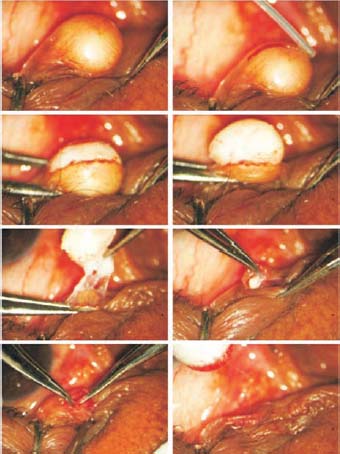
 sebaceous cyst is caused by obstruction of the gland of Zeiss, the meibomian gland, or the sebaceous glands associated with the hair follicles of the eyelid. Sebaceous cysts are solid white or yellowish and present like a tumor beneath the normal skin. The consistency is soft to rubbery.
sebaceous cyst is caused by obstruction of the gland of Zeiss, the meibomian gland, or the sebaceous glands associated with the hair follicles of the eyelid. Sebaceous cysts are solid white or yellowish and present like a tumor beneath the normal skin. The consistency is soft to rubbery.
The standard surgical procedure is to make an incision larger than the diameter of the cyst. Blunt dissection is then done to separate the cyst from the surrounding tissues, and the cyst is removed completely. Bleeding is controlled with cautery, excess skin is excised, and the skin is closed with nylon or silk sutures or absorbable sutures.
CASE STUDY
We treated a 70-year-old patient who had a large (9 mm) sebaceous cyst along the lid margin close to the punctum. A normal surgical procedure could have jeopardized the function of the punctum. Therefore, we took the steps outlined below to remove the cyst.
TECHNIQUE
Anesthesia
Infiltrate lidocaine around the cyst.
Surgical Technique
- Incise the cyst wall very carefully with a 100- µm Fugo blade tip set at the lowest energy levels. The incision should be full length. The contents of the cyst will be visible under the incision (Fig. 5.1).
- Use a plane forceps to hold the cyst at the deepest point, then move the forceps upward, to squeeze out and drain the contents of the cyst. A part of the cyst wall also appears; it should also be pulled out.
- Pull out the visible cyst wall inside the cyst cavity using a fine forceps.
- Excise the loose excess skin. Because the skin edges are naturally approximated, do not apply sutures. If the incision is particularly long, however, a couple of sutures may be needed.

Figure 5.1. A cyst close to the punctum is incised with the Fugo blade. The contents are squeezed out with plain forceps. The wall of the cyst is pulled out. Excess skin is excised. No suture is applied.
Even the most minor-looking ailment needs the best attention, even if it does not threaten the patient’s vision. The cosmetic sensitivity of lesions on the face and especially near the eye demands the least traumatic approach. The Fugo blade is of help in these situations because it can make incisions and remove tissues without burning and charring the adjacent tissue.
Suggested Reading
Kellan R, Fugo RJ. Device increases safety, efficiency of cataract surgery. Ophthalmol Times. 2000;25(22):7–9.
Roy FH. Course of Fugo blade is enlightening, surgeon says. Ocular Surg News. 2001;19:35–38.
Stay updated, free articles. Join our Telegram channel

Full access? Get Clinical Tree


